Eagles are among the most iconic and powerful birds in the world. With their keen eyesight, impressive wingspans, and unmatched hunting abilities, these majestic birds have captivated human imagination for centuries. Whether soaring high above mountain peaks or gliding effortlessly over vast bodies of water, eagles symbolize strength, freedom, and determination. In this article, we will explore the types of eagles, offering an in-depth look at 40 unique species that inhabit various regions around the globe.
The diversity of types of eagles is staggering, with each species exhibiting distinct characteristics, behavior, and habitat preferences. From the well-known Bald Eagle of North America to the rare Philippine Eagle, eagles can be found on every continent except Antarctica. These birds have adapted to a variety of ecosystems, from dense forests and tropical rainforests to open plains and coastal regions, each species perfectly suited to its environment.
Understanding the types of eagles is not only fascinating but also crucial for their conservation. As apex predators, eagles play an essential role in maintaining the balance of their ecosystems. In the following sections, we will take you on a journey through the world of eagles, with detailed descriptions, identification tips, and images to help you recognize these magnificent creatures in the wild.
Different Types of Eagles
Bonelli’s Eagle

Bonelli’s Eagle (Aquila fasciata) is a remarkable bird of prey known for its medium size and exceptional flying abilities. With a wingspan of 150-180 cm, this species displays sexual dimorphism, where females are larger than males. The eagle’s plumage is mainly dark brown, with a golden-brown hue on the head and neck, enhancing its majestic appearance. Its broad wings and short tail give it the agility needed for swift aerial maneuvers, essential for catching prey.
Bonelli’s eagle is a versatile predator, hunting small-to-medium-sized mammals and birds. It relies on stealth and powerful dives to capture prey mid-flight. Unfortunately, the species faces increasing threats from habitat loss, poaching, and human encroachment. With populations in decline, conservation efforts are critical to ensure that Bonelli’s eagle continues to soar across the Mediterranean and Asia.
Crested Eagle
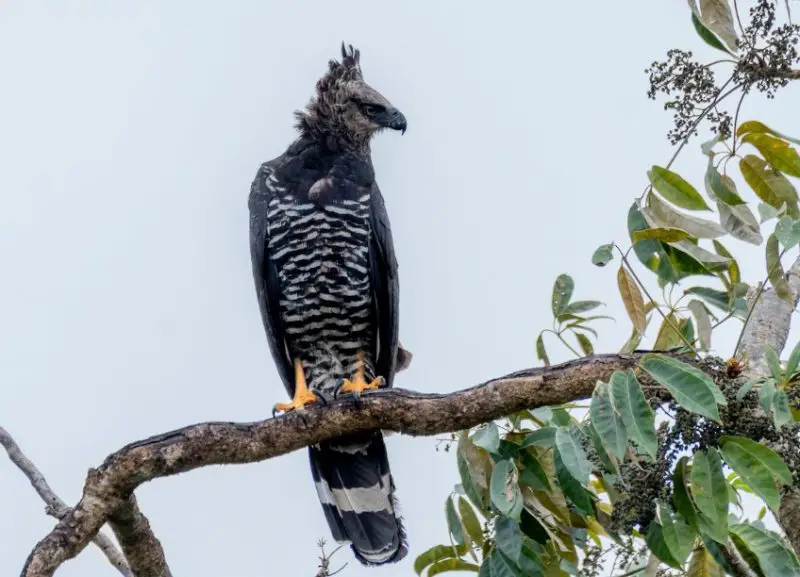
The Crested Eagle (Morphnus guianensis) is a large and impressive bird that stands as a solitary representative of its genus. Found primarily in the dense rainforests of Central and South America, this eagle can reach a length of 89 cm and a wingspan of 176 cm, making it a formidable presence in the sky. Its dark plumage, along with a unique crest on its head, makes it easily identifiable. The eagle’s powerful build and excellent aerial skills make it a top predator in its ecosystem.
The Crested Eagle is a specialized hunter, preying on a variety of animals, including arboreal mammals and birds. While its juvenile counterparts may resemble immature Harpy Eagles, the Crested Eagle has a distinct appearance due to its crest and coloration. As deforestation continues to threaten its habitat, the Crested Eagle’s conservation status is a concern, necessitating efforts to protect the rainforests it calls home.
Bald Eagle

The Bald Eagle (Haliaeetus leucocephalus) is a majestic symbol of strength and freedom, widely recognized as the national bird of the United States. With its signature white head and tail against a dark brown body, this large raptor has a wingspan of up to 7.7 feet. Typically found near large bodies of water, Bald Eagles are expert hunters, primarily feeding on fish, which they catch with remarkable precision.
Bald Eagles mature around the age of five and often form long-lasting monogamous pairs. Their nests, some of the largest among birds, are built near water and are reused year after year. Once endangered due to hunting and pesticide use, the Bald Eagle’s population has rebounded significantly thanks to dedicated conservation efforts. Today, this eagle is classified as a species of least concern, highlighting the success of wildlife protection initiatives.
Crowned Solitary Eagle
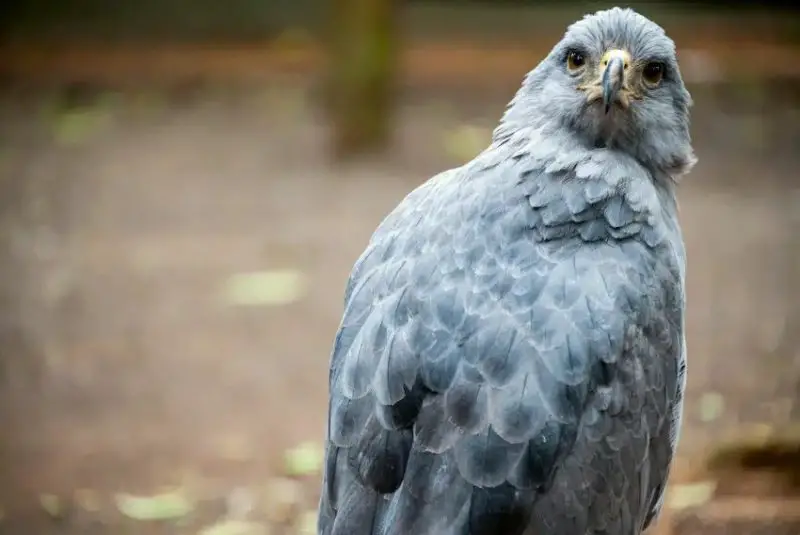
The Crowned Solitary Eagle (Harpyhaliaetus coronatus) is a powerful predator native to South America. It showcases silvery-grey plumage with a striking black tail, accented by a white band and tip. A unique crest of dark feathers crowns its head, giving the eagle its name. Its yellow-tinged legs and cere add to its distinct appearance. This eagle thrives in open or semi-open habitats, using its sharp vision and strong talons to hunt efficiently. Unfortunately, habitat loss has led to a decline in its population, making conservation efforts crucial for its survival.
Initially believed to be related to harpy eagles, genetic studies have shown that the Crowned Solitary Eagle is more closely linked to the genus Buteogallus, especially the Great Black Hawk. These raptors prefer expansive terrains where they can hunt without obstruction. However, deforestation and human encroachment pose significant threats to their habitats. Conservationists emphasize the importance of habitat protection and further research to understand this species better. Protecting the Crowned Solitary Eagle is essential for maintaining the ecological balance in its native regions.
Black Solitary Eagle
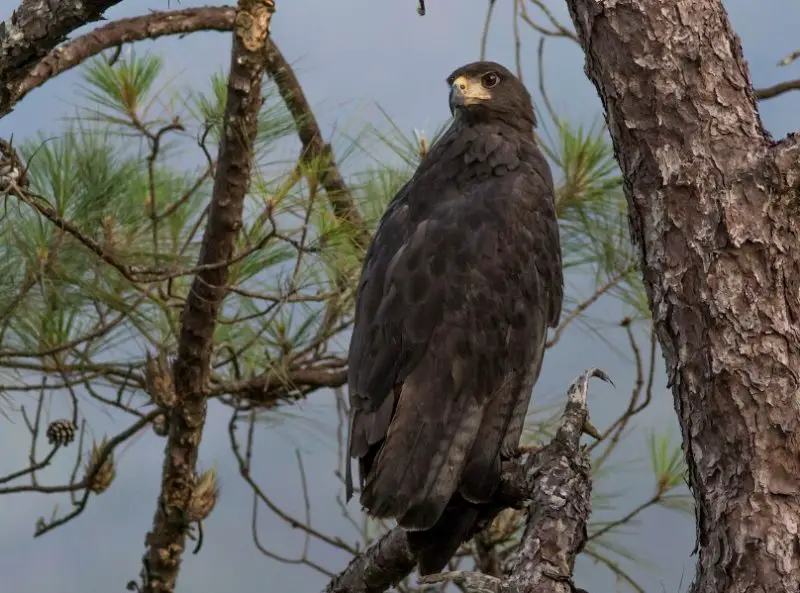
The Black Solitary Eagle (Harpyhaliaetus solitarius) is a rare and enigmatic raptor found from Mexico to Argentina. It is known for its dark gray plumage and distinct white band on its tail. This solitary hunter thrives in dense forests and mountainous terrains, where it preys on small mammals and birds. Its sharp vision and powerful build make it a formidable predator. However, its elusive nature and low population density make it challenging to study, leading to limited knowledge about its behavior and population trends.
This eagle is typically found in remote regions, preferring expansive forests and rugged landscapes. Despite its adaptability, habitat destruction due to deforestation and human activities threatens its existence. Although not currently endangered, the Black Solitary Eagle’s population is declining. Conservationists are working to protect its habitat and raise awareness about its ecological importance. Preserving this majestic bird is vital to maintaining biodiversity and the health of its ecosystem.
Black-Chested Buzzard-Eagle
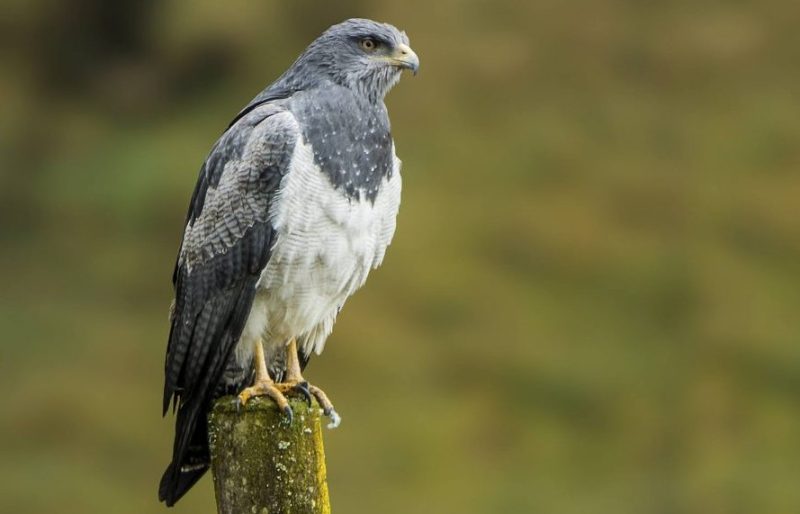
The Black-chested Buzzard-Eagle (Geranoaetus melanoleucus) is a powerful bird of prey native to South America. It boasts gray upperparts with a distinctive black chest, giving it its name. With broad wings and a relatively short tail, this eagle is an agile flyer, perfectly adapted to hunting in open terrains. It builds solitary nests on high trees or rocky cliffs, providing excellent vantage points for hunting rodents and other small mammals, helping maintain ecological balance in its habitat.
This eagle is known for its solitary nature, often soaring high in the sky, showcasing its impressive wingspan. Its robust beak and talons highlight its predatory prowess. Although it inhabits isolated areas, habitat encroachment and human activities pose threats to its survival. Conservationists emphasize the need for habitat preservation and monitoring of population trends. Protecting the Black-chested Buzzard-Eagle ensures the continued health of its ecosystem, where it plays a vital role as a top predator.
Harpy Eagle
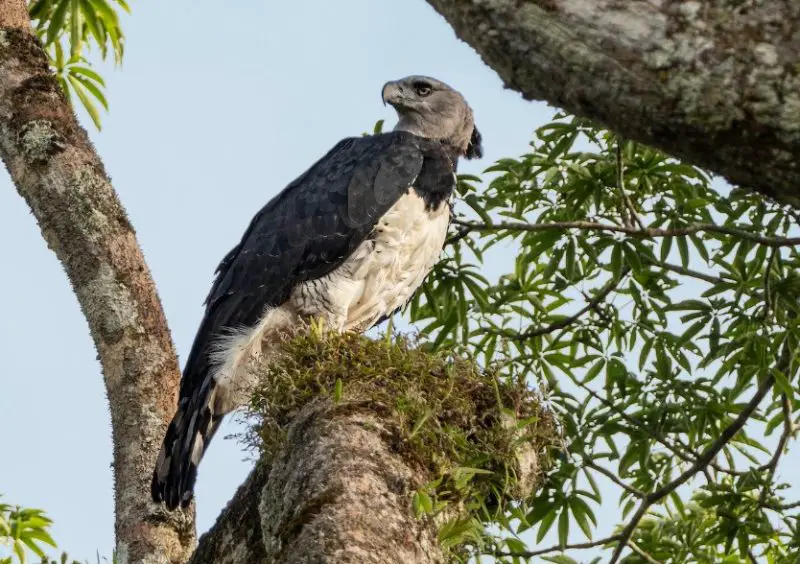
The Harpy Eagle (Harpia harpyja) is one of the largest and most powerful eagles in the world, native to the tropical rainforests of South America. It features a striking feathered crest and an impressive wingspan of up to 2 meters. Its massive talons, comparable to bear claws, allow it to hunt large prey like monkeys and sloths. The Harpy Eagle’s muscular build and agility make it a master of navigating dense forest canopies, maintaining its position as an apex predator in its ecosystem.
Despite its strength and adaptability, the Harpy Eagle faces significant threats from deforestation and habitat loss. Its population is rapidly declining, leading to conservation concerns. Efforts are underway to protect its rainforest habitat and promote awareness of its ecological significance. As a top predator, the Harpy Eagle helps regulate prey populations, maintaining the balance of its ecosystem. Conserving this majestic bird ensures the preservation of the intricate web of life within tropical rainforests.
Papuan Eagle
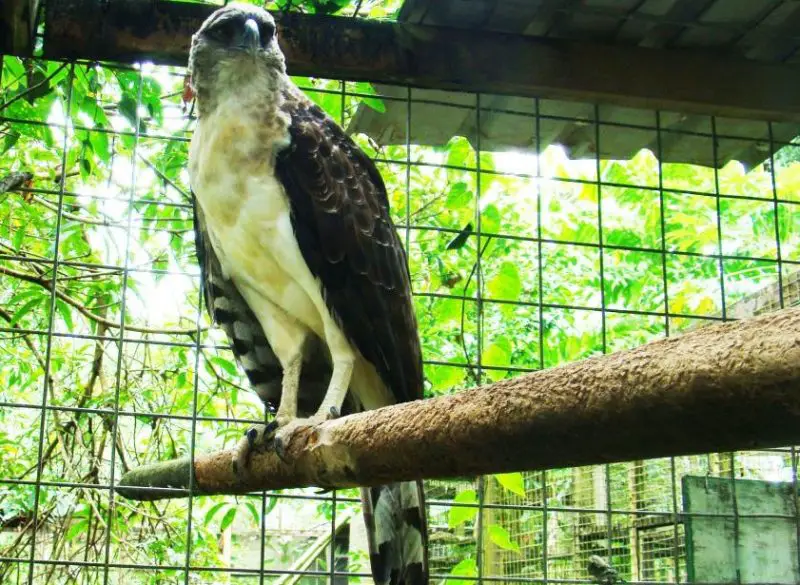
The Papuan Eagle (Harpyopsis novaeguineae), native to New Guinea, is a formidable raptor known for its large size and powerful hunting abilities. It inhabits dense rainforests, displaying broad wings and sharp talons perfect for catching small mammals and birds. Sexual dimorphism is evident, with females being larger than males. Their brownish-gray plumage provides excellent camouflage within the forest canopy, allowing them to stalk prey undetected before striking with precision.
The Papuan Eagle is a top predator, crucial for maintaining ecological balance by controlling prey populations. However, deforestation and human encroachment threaten its habitat, leading to population declines. Its elusive nature makes it difficult to study, resulting in limited data on its behavior and numbers. Conservationists prioritize habitat preservation and further research to protect this species. Safeguarding the Papuan Eagle is essential for preserving New Guinea’s rich biodiversity and ecological integrity.
Philippine Eagle
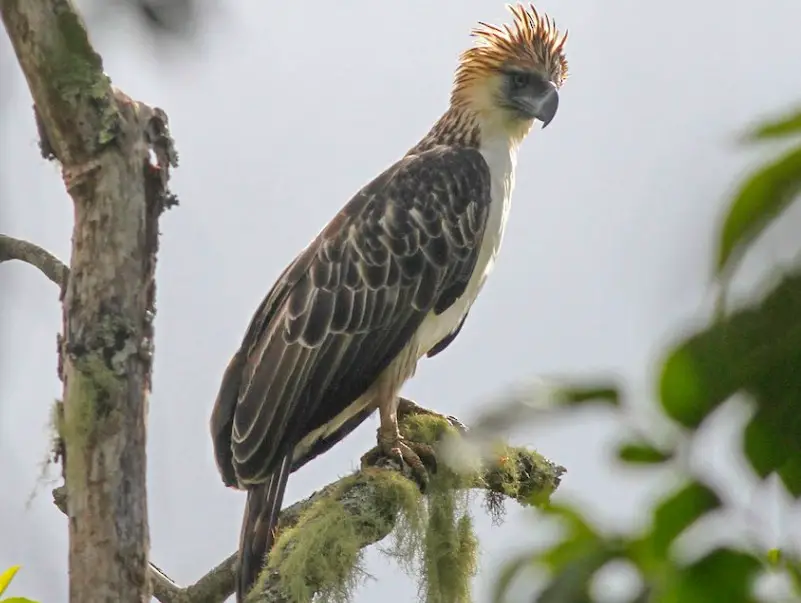
The Philippine Eagle (Pithecophaga jefferyi) is one of the largest and most powerful eagles in the world. It features a distinctive shaggy crest of brown feathers on its nape, contrasting with its dark face and creamy-brown crown. Its back is dark brown, while its underside is pure white. With a wingspan of 184 to 220 centimeters, it skillfully navigates the dense forest canopies of the Philippines. This majestic bird is an apex predator, primarily hunting medium-sized animals like flying lemurs and monkeys.
Sadly, the Philippine Eagle is critically endangered, with an estimated population of only 250 to 600 individuals left in the wild. Deforestation and habitat destruction are the main threats to its survival. Conservation efforts are crucial to protect this national symbol and maintain the ecological balance it helps sustain. With a lifespan of up to 60 years in the wild, safeguarding this species also means preserving an essential part of the Philippines’ natural heritage.
Black Eagle
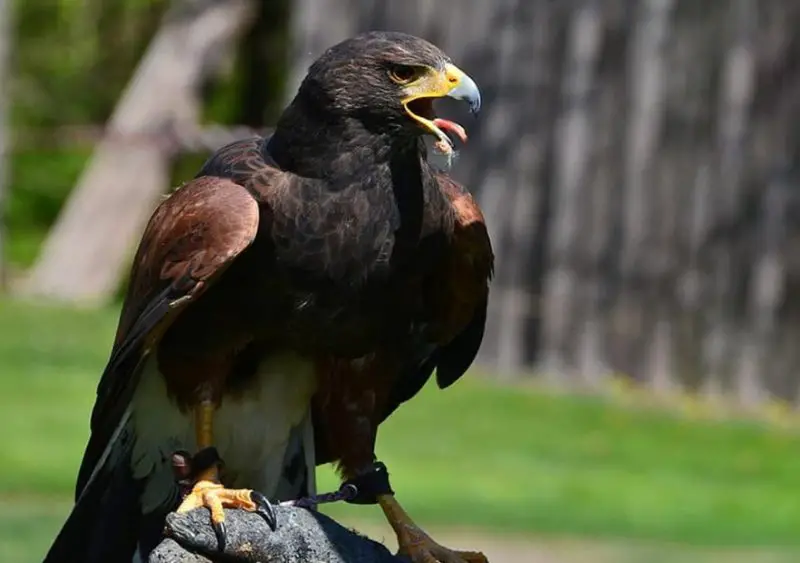
The Black Eagle (Ictinaetus malaiensis) is known for its striking dark plumage, making it easily recognizable against the bright sky. It inhabits dense tropical forests from the Himalayan foothills to Southeast Asia, including India and Sri Lanka. This medium-sized eagle has a body length of 70 to 80 cm and an impressive wingspan ranging from 178 to 220 cm. It soars gracefully along mountain ridges, using updrafts to glide effortlessly over its territory.
A skilled hunter, the Black Eagle primarily preys on birds, small mammals, and reptiles. It builds large nests on tall trees or cliff edges, showcasing its adaptation to forest life. Unfortunately, deforestation and habitat fragmentation threaten its survival. Conservation efforts are focused on protecting its forest habitat, which is crucial for maintaining the ecological balance where this predator plays a key role. The Black Eagle’s majestic presence highlights the importance of forest conservation.
Lesser Spotted Eagle
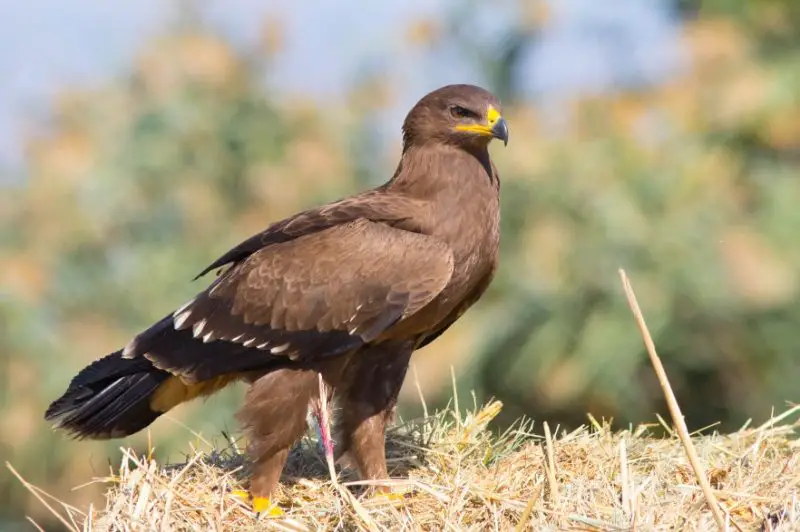
The Lesser Spotted Eagle (Clanga pomarina) is a medium-sized raptor known for its small head and distinct plumage. Adults exhibit a two-tone pattern with dark flight feathers contrasting against a lighter body, while juveniles show bold white bars on their back and wings. This species prefers forested regions near water sources across Europe and Asia, where it hunts small mammals, birds, and reptiles.
In flight, the Lesser Spotted Eagle displays a unique double white underwing pattern, helping distinguish it from other eagles. Habitat loss poses a significant threat to its populations, prompting conservationists to focus on protecting its natural habitats. Conservation programs targeting forest preservation are essential for safeguarding this species. By maintaining these ecosystems, the Lesser Spotted Eagle can continue to play its role as a top predator in its environment.
Indian Spotted Eagle
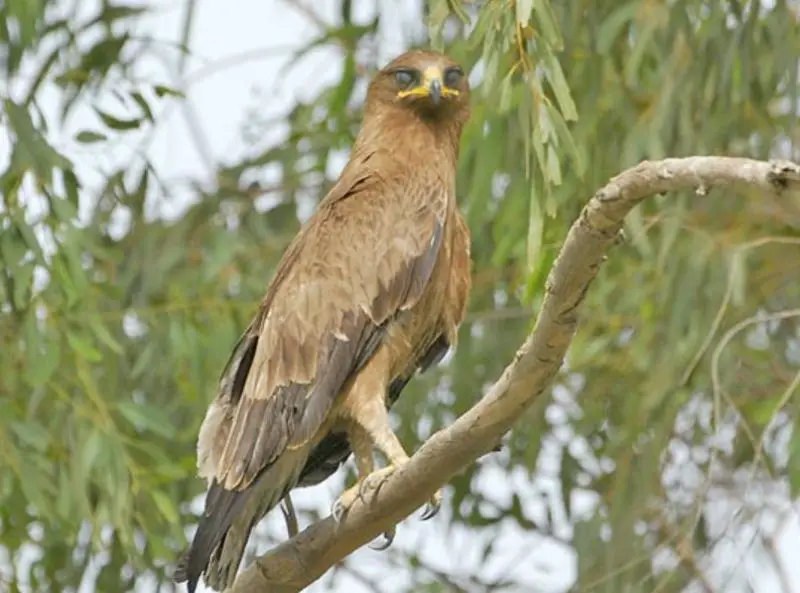
The Indian Spotted Eagle (Aquila hastata) is native to the Indian subcontinent, easily identified by its dark brown plumage with paler spots. It typically measures about 60 cm in length, with a wingspan of approximately 150 cm. This eagle thrives in open forests, woodlands, and farmlands, where it hunts small mammals and birds. Its large platform nests are usually built high in trees, ensuring safety for its young.
Despite its adaptability, the Indian Spotted Eagle faces threats from habitat loss and degradation, leading to its classification as vulnerable by the IUCN. Conservation efforts are crucial to protect its habitats and support population recovery. As an apex predator, this eagle helps control small animal populations, maintaining ecological balance. Preserving its environment is essential for sustaining the biodiversity of the Indian subcontinent.
Tawny Eagle
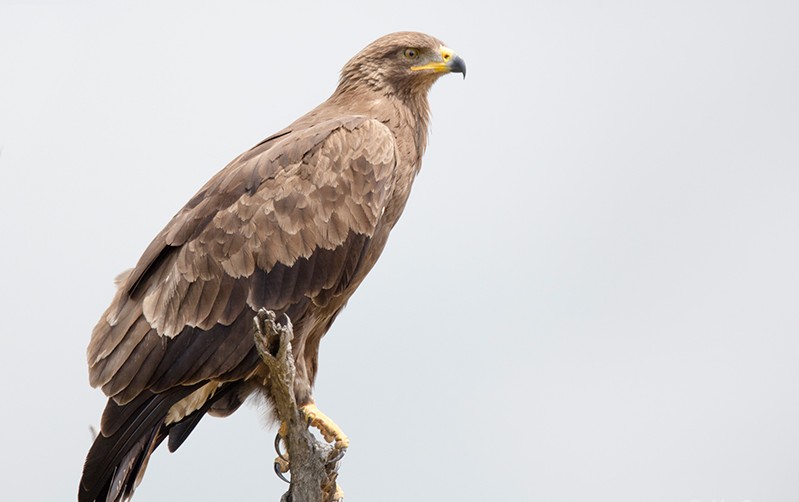
The Tawny Eagle (Aquila rapax) is known for its predominantly tawny-colored plumage, contrasting with darker flight feathers. It measures 65 to 72 centimeters in length, with a wingspan ranging from 1.72 to 1.85 meters. This booted eagle, with feathered legs, is widely distributed across Africa and parts of Asia, showcasing remarkable adaptability to various habitats, including savannas and semi-deserts.
A versatile hunter, the Tawny Eagle preys on small mammals, birds, and carrion, reflecting its opportunistic feeding behavior. It is a solitary breeder, often returning to the same nesting site each year. Despite its adaptability, populations are declining due to habitat destruction, human-wildlife conflict, and changes in prey availability. Conservation initiatives focus on protecting habitats and mitigating threats. Safeguarding the Tawny Eagle ensures the preservation of its ecological role as a top predator.
Spanish Imperial Eagle
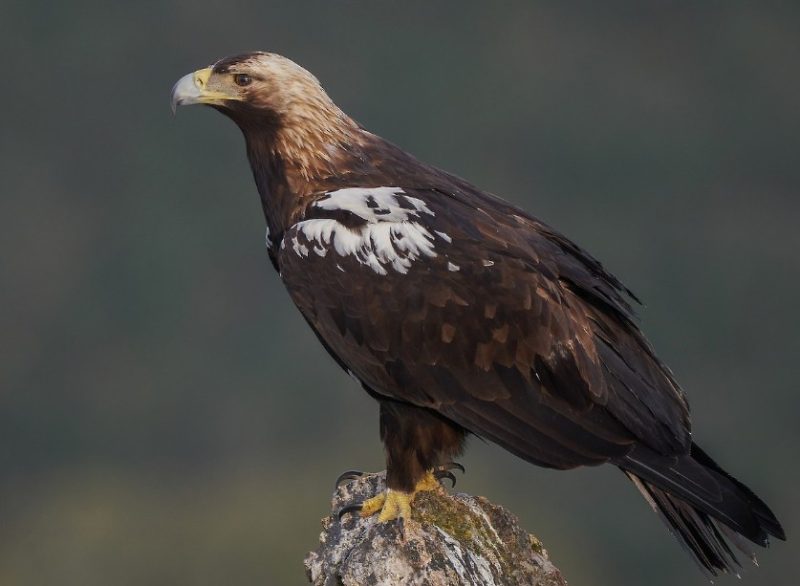
The Spanish Imperial Eagle (Aquila adalberti) is native to the Iberian Peninsula, primarily found in Spain and Portugal. Recognizable by its large size and distinctive white “epaulettes” on its shoulders, this eagle displays dark brown plumage with a paler cream-colored head and neck. It prefers forested habitats near water bodies, often inhabiting dehesas and open woodlands.
This species mainly feeds on rabbits, making its population vulnerable to fluctuations in prey availability. It also preys on medium-sized mammals and occasionally birds. Juveniles are distinguishable by their rufous to pale brown coloration with dark flight feathers.
The Spanish Imperial Eagle is threatened by habitat loss and fragmentation, highlighting the need for ongoing conservation efforts. It is currently listed as threatened, and habitat protection is crucial for its survival. Conservation programs have been effective in stabilizing populations, ensuring the continued existence of this majestic raptor.
Greater Spotted Eagle
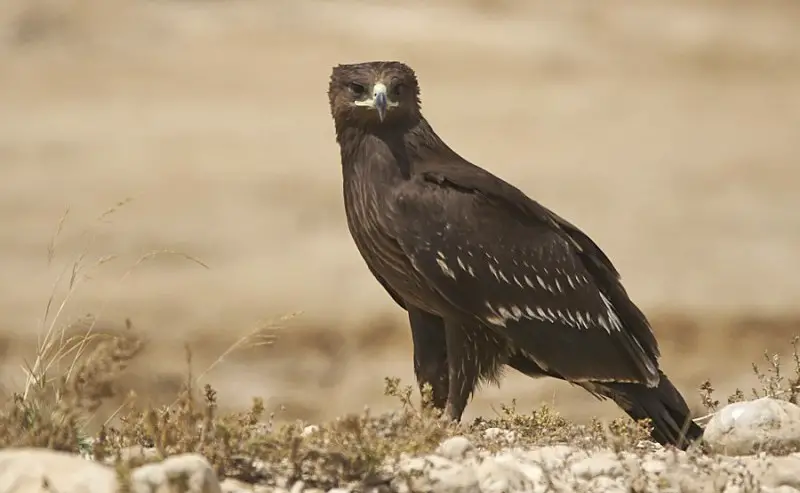
The Greater Spotted Eagle (Clanga clanga) is a booted eagle known for its predominantly dark brown plumage and distinctive white comma-shaped marking on the underwing. It is commonly found across Europe and Asia, migrating to parts of Africa and India during winter. This species favors wetlands, remote forested areas, and river valleys for nesting and hunting.
It preys on small mammals and birds, using its broad wings to soar and dive swiftly to capture prey. Unfortunately, habitat loss and human disturbance have led to declining populations, categorizing it as vulnerable. Conservation efforts are essential to protect its habitats and ensure the survival of this remarkable raptor.
Steppe Eagle
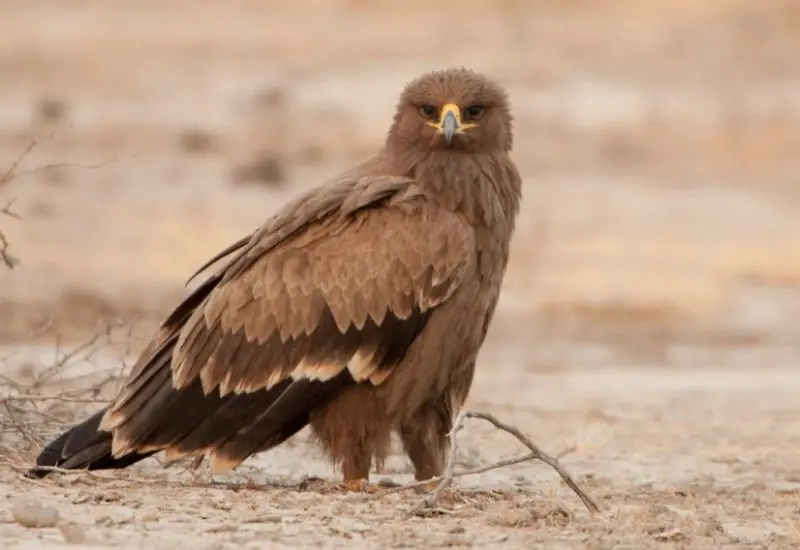
The Steppe Eagle (Aquila nipalensis) is a large raptor recognized for its brown plumage with lighter feathers on the nape and crown. It inhabits open grasslands and semi-desert regions, feeding opportunistically on small mammals, birds, and carrion. This eagle is known for its long migration patterns, traveling vast distances between breeding and wintering grounds.
With a wingspan of 165 to 215 cm and a weight ranging from 2 to 4.9 kg, the Steppe Eagle exhibits powerful flight and hunting skills. However, it is currently listed as endangered due to habitat loss and other human-induced threats. Conservation efforts include habitat protection, anti-poisoning measures, and awareness campaigns to preserve this species.
Eastern Imperial Eagle
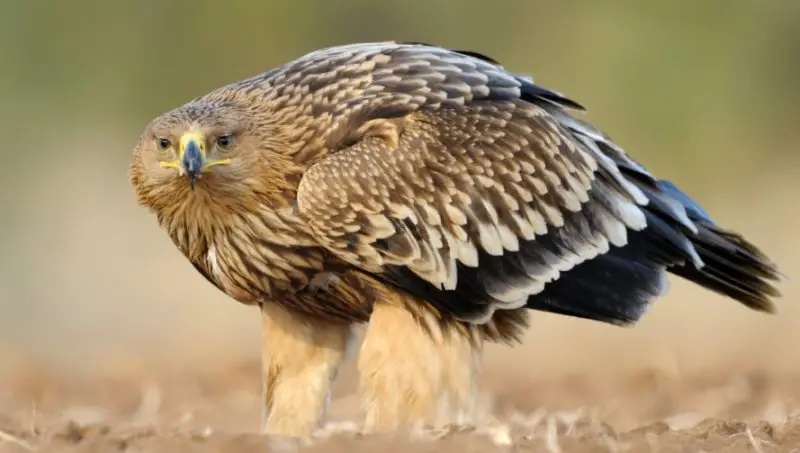
The Eastern Imperial Eagle (Aquila heliaca) is a large raptor with a wingspan of up to 7.2 feet. It displays dark brown plumage with a paler head and nape, making it visually striking. This species breeds in southeastern Europe and Central Asia, migrating to winter in northeastern Africa, the Middle East, and South and East Asia.
Juveniles are characterized by a sandy brown color with streaks and a pale rump contrasting with dark tail and flight feathers. Conservation efforts, including the Eastern Imperial Eagle Working Group, focus on protecting breeding habitats and reducing human impacts. Once considered a subspecies of the Spanish Imperial Eagle, it is now recognized as a distinct species.
Gurney’s Eagle

Gurney’s Eagle (Aquila gurneyi) inhabits lowland and foothill forests, displaying dark brown to black plumage with paler undersides on its flight feathers. It has a body length of 74-86 cm and a wingspan of 1.65 to 1.9 m. Known for its powerful flight, this eagle is typically seen soaring alone or in pairs.
Juveniles exhibit a mix of brown, gray, and buff on their backs and wing coverts, gradually transitioning to the adult plumage over time. Gurney’s Eagle plays a crucial ecological role as a top predator, maintaining the balance of its habitat. Conservation efforts are necessary to protect its forest habitats and ensure population stability.
Wahlberg’s Eagle
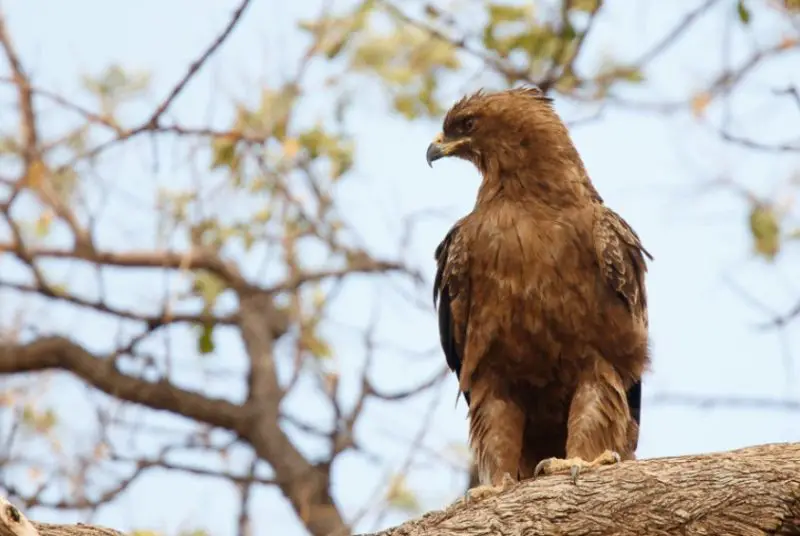
Wahlberg’s Eagle (Hieraaetus wahlbergi) is a medium-sized raptor found in sub-Saharan Africa, known for its migratory patterns across woodlands and savannas. It has a distinctive squared silhouette due to its short crest and a smaller head and beak compared to larger eagles. Its plumage is typically chocolate-brown, although some individuals exhibit paler morphs.
This eagle is an adaptable hunter with a varied diet that includes birds (even other raptors), reptiles such as lizards and snakes, and small mammals. Occasionally, it also consumes invertebrates like termites and beetles. Wahlberg’s Eagle is closely related to Ayres’s Hawk Eagle and the Little Eagle.
Named after Swedish naturalist Johan August Wahlberg, this species is a seasonal migrant, moving in sync with prey availability and breeding conditions. Its adaptability and role as a predator make it an important species for monitoring ecological changes in its habitat.
Golden Eagle
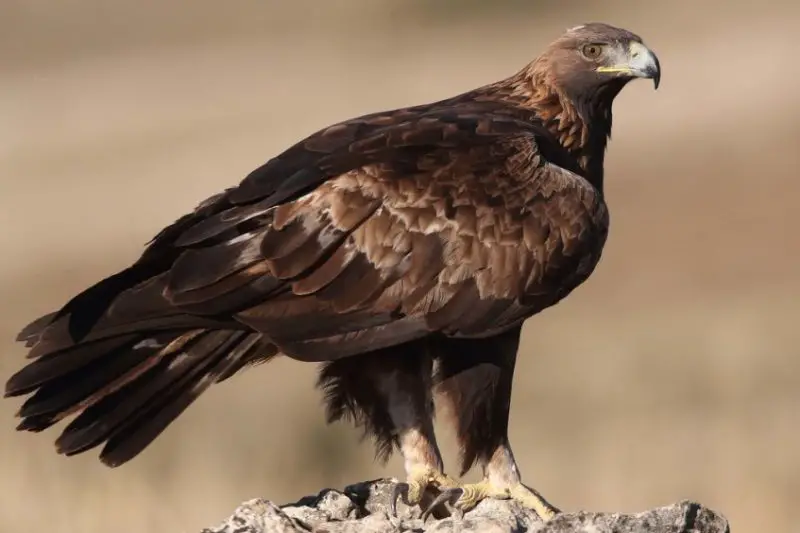
The Golden Eagle (Aquila chrysaetos) is one of the largest and most powerful raptors in North America, recognized for its lustrous gold-hued plumage on the head and neck. Its robust beak and talons highlight its hunting prowess, primarily preying on small mammals like jackrabbits. Unlike the fish-eating Bald Eagle, Golden Eagles have a broader diet and are known to hunt in open or semi-open landscapes.
With a wingspan of up to 2.3 meters, they efficiently soar on thermal currents, conserving energy during long flights. These raptors exhibit remarkable territorial fidelity, with pairs often occupying the same territory for generations. As apex predators, Golden Eagles play a vital ecological role, symbolizing wilderness and conservation efforts worldwide.
Booted Eagle
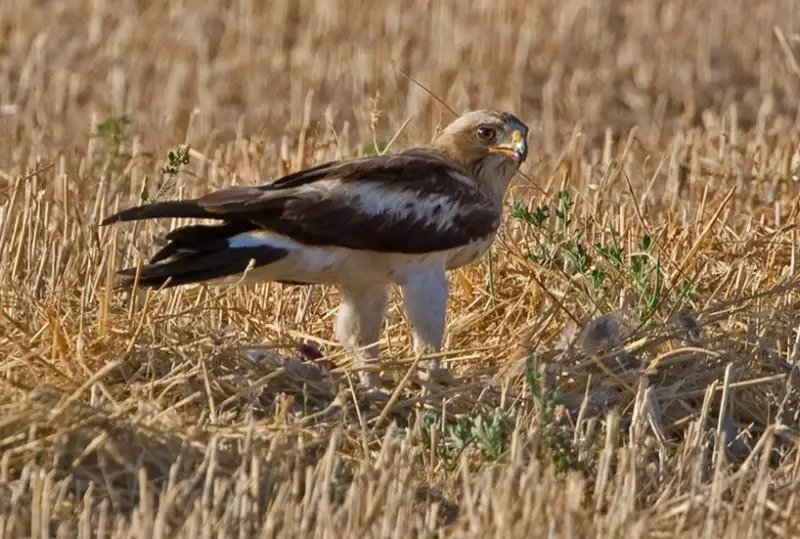
The Booted Eagle (Hieraaetus pennatus) is a medium-sized raptor known for its remarkable morphological diversity and feathered ‘boot’ legs. Comparable in size to the common buzzard, this eagle displays two distinct plumage morphs: pale and dark. Males weigh between 510-770 grams, while females are larger at 840-1,025 grams. They have a wingspan of 110-132 cm, showcasing agility and hunting skill.
The species inhabits regions from Europe to Asia, migrating to Sub-Saharan Africa and the Indian Subcontinent during winter. It prefers diverse habitats, including open woodlands and steppes. Despite its relatively stable conservation status, ongoing monitoring is essential to understand its adaptability and ecological role as a predator.
Wedge-Tailed Eagle
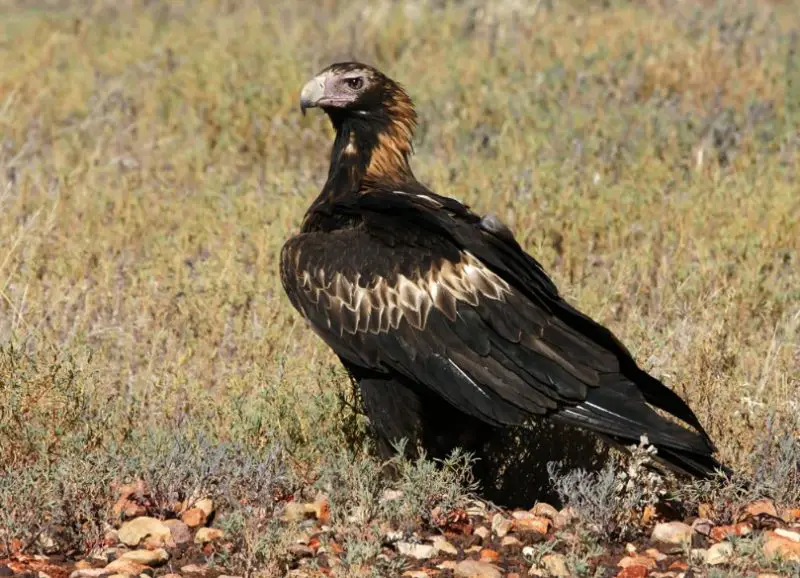
The Wedge-Tailed Eagle (Aquila audax) is Australia’s largest bird of prey, recognized by its distinctive wedge-shaped tail and broad wingspan of about 2.3 meters. This powerful raptor is found across Australia and Tasmania, soaring over vast landscapes with its dark plumage and feathered legs extending to the toes.
Adult Wedge-Tailed Eagles weigh between 3.2 to 5.3 kg and exhibit dark brown coloring with a paler nape and cream or pinkish bill. Their sharp vision and strong talons make them formidable hunters, preying on rabbits, reptiles, and other small mammals.
Classified as “Least Concern” by the IUCN, this species has a stable population due to effective conservation efforts. It plays a crucial ecological role as a top predator, maintaining the balance of its environment.
African Hawk-Eagle
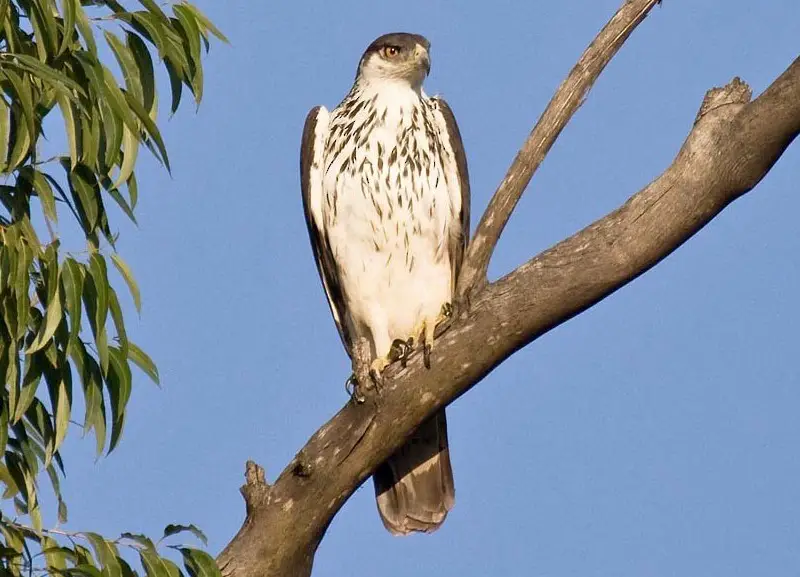
The African Hawk-Eagle (Aquila spilogaster) is a medium-sized raptor residing in semi-arid rangelands, savannas, and riverine forests throughout sub-Saharan Africa. It is known for its striking dark-and-white plumage pattern, with brown and white underwings bordered by a thick black edge. The tail is pale gray with a distinct dark bar at the end, while immature birds exhibit rufous underparts, including underwings.
This agile predator preys on small mammals and birds, using its sharp vision and hunting skills. Often confused with the Bonelli’s Eagle, it is now recognized as a distinct species. The African Hawk-Eagle plays a critical ecological role by regulating the populations of smaller animals, contributing to biodiversity and ecosystem health.
Little Eagle
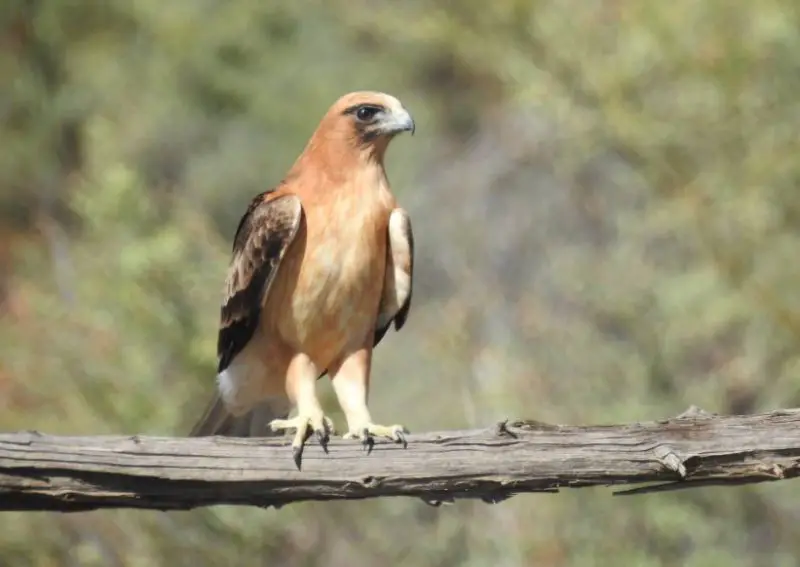
The Little Eagle (Hieraaetus morphnoides) is a small raptor native to Australia, known for its compact size. Adults typically reach up to 55 cm in length and weigh around 815 grams, with females generally larger than males. Their plumage displays shades of grey and brown, with paler undersides and a distinctive M-shaped marking visible when soaring.
These eagles inhabit diverse landscapes, including open woodlands, grasslands, and semi-arid regions, while avoiding dense forests. They are opportunistic hunters, preying on rabbits, small mammals, birds, and reptiles. Their hunting techniques include high soaring and rapid, low-level flights to surprise their prey.
Little Eagles nest in tall trees, constructing large stick nests. During breeding season, they engage in aerial displays for courtship and territorial defense. Although currently listed as “Least Concern,” they face threats from habitat alteration and human encroachment. Conservation efforts continue to monitor and protect this adaptable raptor.
Verreaux’s Eagle

Verreaux’s Eagle (Aquila verreauxii), also known as the Black Eagle, is a powerful raptor found in sub-Saharan Africa. Preferring mountainous regions, they nest on rocky cliffs and ledges. This eagle is notable for its striking black plumage with contrasting white patches on its wings and back, visible in flight.
They are large birds, measuring 75-96 cm in length with a wingspan of 1.81-2.3 meters and weighing between 3-6 kg. Verreaux’s Eagles specialize in hunting rock hyraxes but also feed on small mammals and birds. Their agility and strength make them highly effective predators.
Despite being classified as “Least Concern,” local populations face challenges from habitat loss and human disturbance. Their elaborate aerial courtship displays highlight their complex mating behaviors. Conservation strategies focus on preserving their natural habitats to ensure long-term survival.
Black-And-Chestnut Eagle
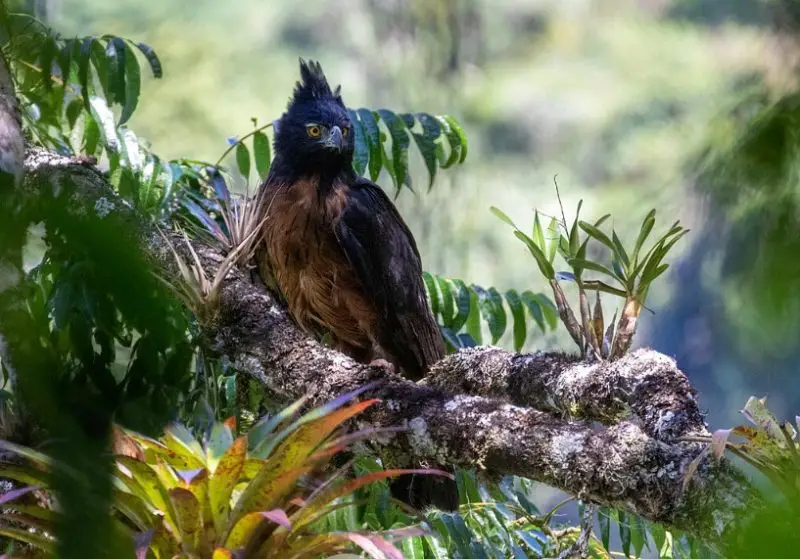
The Black-and-Chestnut Eagle (Spizaetus isidori) inhabits the cloud forests of South America, ranging from Venezuela to Argentina. Recognizable by its crested head, this raptor features predominantly black plumage with rich chestnut coloring on the breast and belly. In flight, white patches are visible on the wings and at the base of the tail.
Juveniles differ significantly, with darker backs, white underparts, and distinctive banding on wings and tails. Although they resemble the pale morph of the Crested Eagle, Black-and-Chestnut Eagles have shorter tails and less pronounced barring.
This species is considered vulnerable due to habitat loss and fragmentation. Conservation efforts focus on protecting cloud forest ecosystems to safeguard this rare and majestic raptor’s future.
Ayres’s Hawk-Eagle
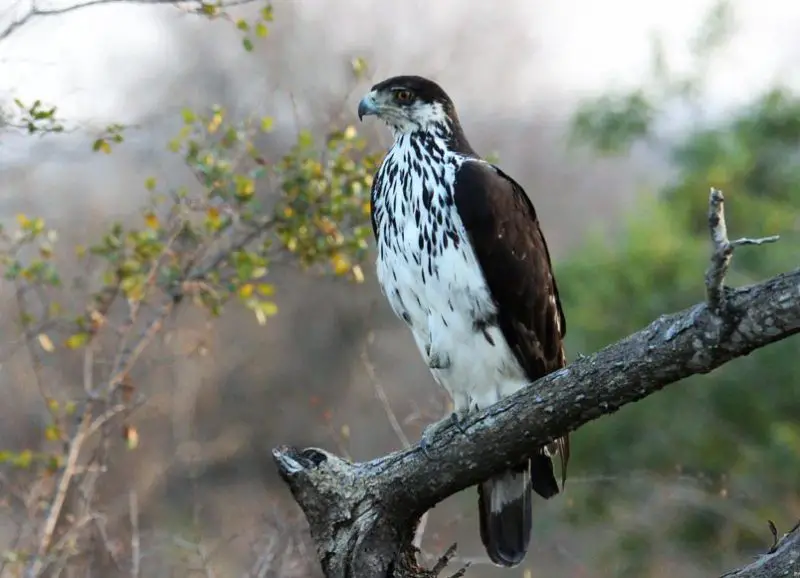
Ayres’s Hawk-Eagle (Hieraaetus ayresii) is a compact bird of prey known for its striking black-and-white plumage. It has bold black markings on the underparts and underwing feathers, making it easily identifiable in flight. Adults feature a small crest, yellow eyes, and a gray beak with a black tip.
They inhabit thick woodlands and forests, where they soar in search of prey. Ayres’s Hawk-Eagles vocalize with a distinctive “kwee-ya” call, aiding identification among forest sounds. Their nests are built in tall trees, sometimes reusing old nests from other raptors.
This species shares close genetic ties with the Booted Eagle and Little Eagle, with Wahlberg’s Eagle being a close relative. Conservation efforts aim to protect their habitats, as they play a vital role in regulating populations of small mammals, birds, and reptiles.
Ornate Hawk-Eagle
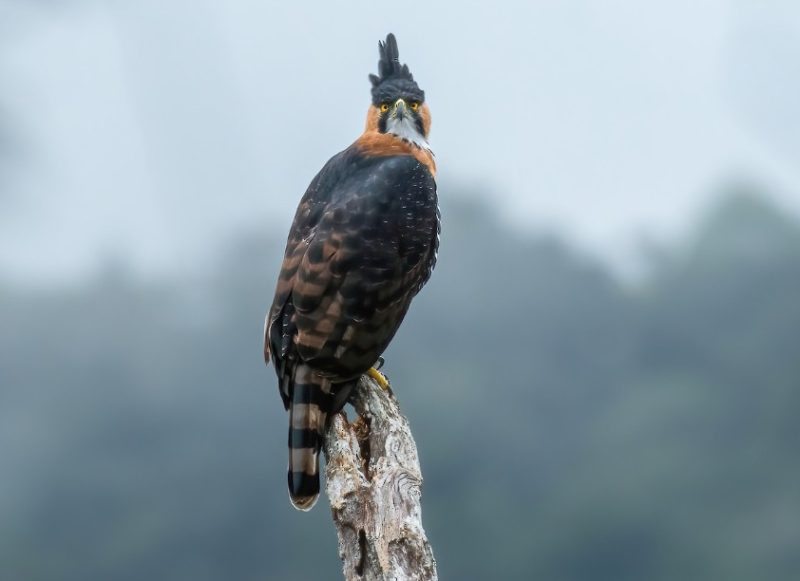
The Ornate Hawk-Eagle (Spizaetus ornatus) is a striking raptor found in the tropical Americas. It is easily recognized by its long black crest feathers, robust body, and barred underparts. Adults display an orange tint on the sides of their heads, complemented by piercing golden eyes.
This eagle resides in dense lowland and foothill forests, well-adapted to canopy life. It hunts birds and small to medium-sized mammals, occasionally supplementing its diet with reptiles. Known for its distinctive hiccupping whistles, the Ornate Hawk-Eagle is often heard before it is seen.
Juveniles are less colorful than adults but share similar hunting skills. The species is dependent on forest habitats, and conservation efforts focus on protecting these environments to ensure the survival of this remarkable predator.
Pygmy Eagle

The Pygmy eagle (Hieraaetus weiskei) is a small but remarkable bird of prey. It measures just 38 to 48 centimeters in length, making it one of the smallest eagles. Despite its diminutive size, this raptor displays all the characteristics typical of eagles, such as sharp talons and exceptional vision. It primarily resides within limited areas, making it a rare sight in the wild. Because of its restricted habitat and scarce studies, its conservation status remains unclear, underlining the need for more research and conservation efforts.
In addition to its small size, the Pygmy eagle holds evolutionary importance in the eagle lineage. As part of the Aquilinae subfamily, it contributes to the ecological balance of its region. This eagle’s elusive nature and the ongoing challenges in understanding its behavior present unique opportunities for scientific exploration. Increased efforts to study its habits and conserve its environment are essential to ensure the survival of this distinctive species.
Martial Eagle
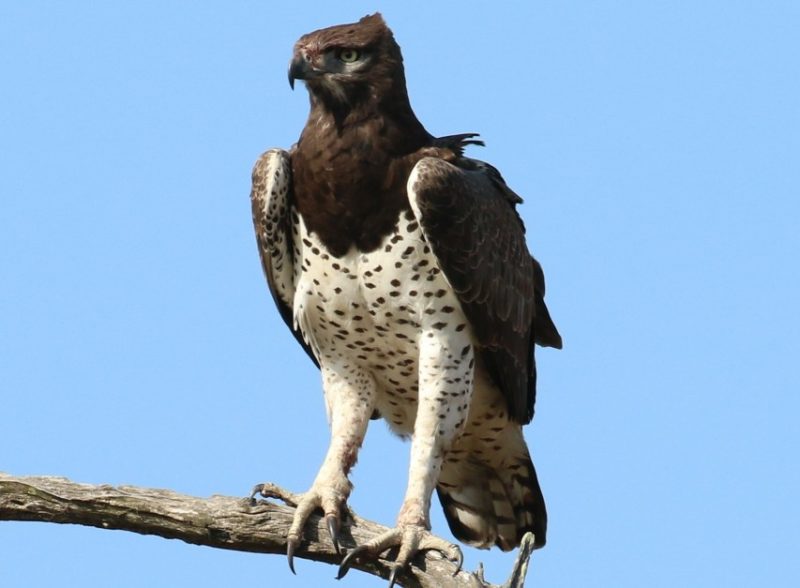
The Martial eagle (Polemaetus bellicosus) stands out as one of the largest eagles, found in sub-Saharan Africa. Measuring up to 96 cm in length and weighing up to 6.5 kg, this formidable bird of prey is well-adapted to the harsh conditions of dry grasslands and sparse woodlands. Its powerful talons and large wings make it an exceptional predator, capable of hunting a wide variety of prey, including small mammals and other birds. Its impressive size and strength make it a symbol of dominance in its ecosystem.
Although the Martial eagle’s size and hunting prowess make it a majestic figure, it faces significant threats, including habitat loss and human persecution. Conservationists are working to protect this species by focusing on preserving its natural habitats and reducing conflicts with humans. As an apex predator, the Martial eagle plays a critical role in controlling prey populations, maintaining the ecological balance in its environment.
Black Hawk-Eagle
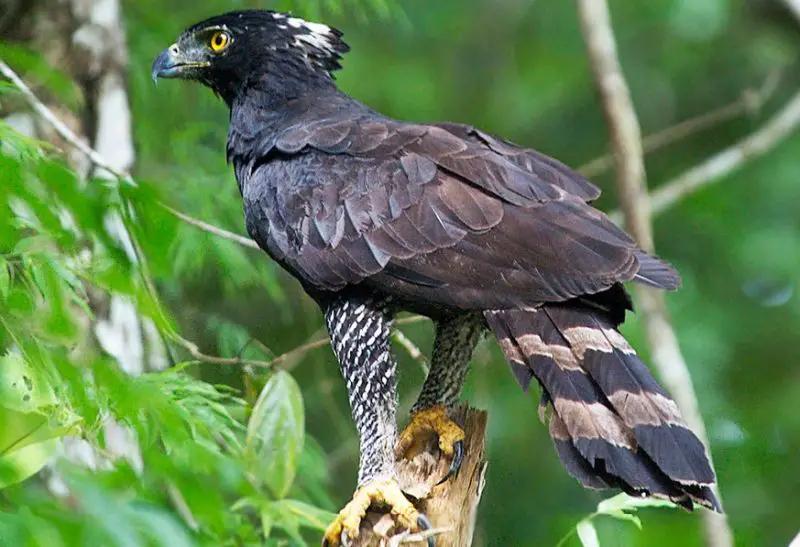
The Black Hawk-Eagle (Spizaetus tyrannus) is a striking and powerful raptor native to the dense tropical forests of Central and South America. It stands out with its predominantly black plumage, adorned with white patterns on its wings and tail, and its distinct yellow cere. Measuring between 58 to 70 cm in length, this eagle is known for its loud whistles and crested silhouette, making it easily recognizable in flight. It primarily preys on small mammals, birds, and reptiles, showcasing its versatility as a hunter.
This species thrives in the lowland tropical forests from Mexico to Argentina, but its survival is increasingly threatened by habitat destruction. Despite not being classified as endangered, the Black Hawk-Eagle faces risks from deforestation and environmental degradation. Conservation efforts are essential to protect the habitats of this impressive bird, ensuring that its population remains stable and its ecological role continues to be fulfilled.
Long-Crested Eagle
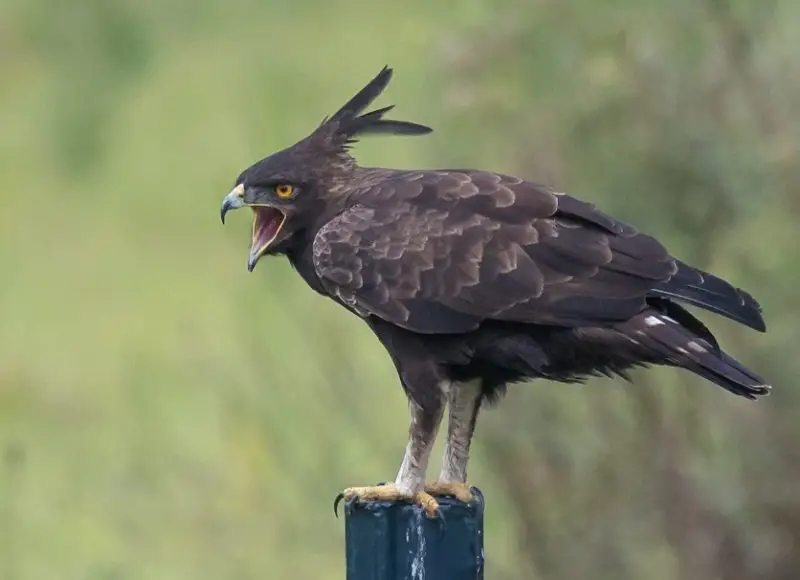
The Long-Crested Eagle (Lophaetus occipitalis) is a unique raptor found in sub-Saharan Africa. Easily identifiable by its prominent, shaggy crest and dark plumage, this eagle thrives in woodlands, plantations, and open forests. Its body length ranges from 55 to 65 cm, and its wingspan extends to about 1.2 meters. Unlike many other eagles, the Long-Crested Eagle prefers perching for extended periods rather than soaring, an adaptation suited to its hunting style, which includes small mammals and birds.
The Long-Crested Eagle’s distinctive call and powerful presence make it a notable figure in its habitat. Though not as widely recognized as other eagles, its role in controlling small mammal populations is vital to maintaining ecological balance. Protecting the habitats of this eagle, along with its relatively quiet behavior and low conservation profile, is crucial for its long-term survival in Africa.
Crowned Hawk-Eagle
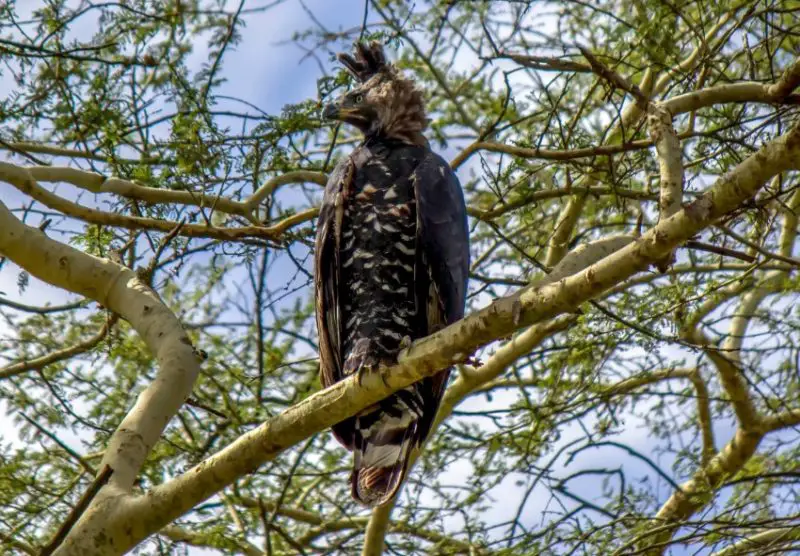
The Crowned Hawk-Eagle (Nisaetus coronatus) is a majestic raptor found in various habitats across Asia, from dense evergreen forests to open savannas. This eagle is easily distinguished by its regal head crest and strong build, with a wingspan that enhances its mastery of the skies. It preys on a range of mammals and birds, underscoring its apex predatory status. Its preference for habitats like forested ravines and montane regions speaks to its adaptability in diverse environments.
Known for its elaborate courtship rituals and long nesting periods, the Crowned Hawk-Eagle requires specific conservation efforts to ensure its survival. Habitat fragmentation poses a significant threat to this species, making habitat preservation a priority for conservationists. By safeguarding its habitats and understanding its complex life cycle, efforts can be made to ensure the Crowned Hawk-Eagle continues to thrive in its natural environment.
Black-and-White Hawk-Eagle
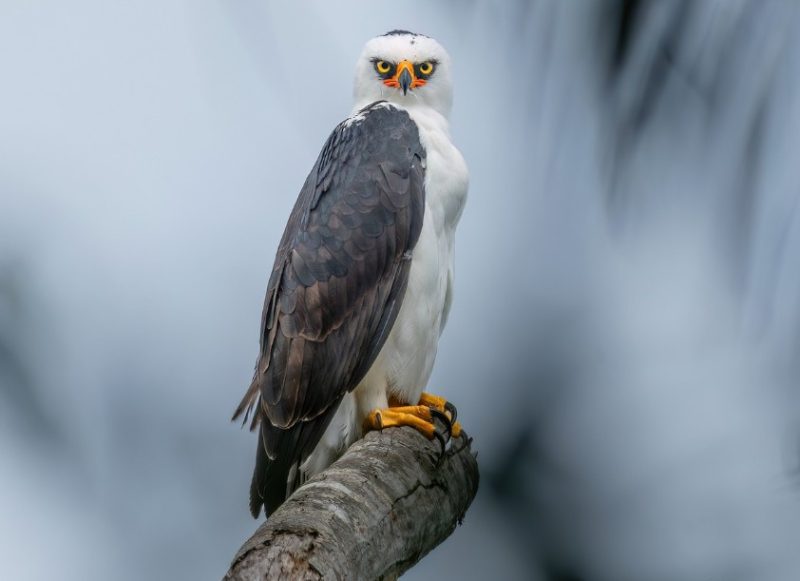
The Black-and-White Hawk-Eagle (Spizaetus melanoleucus) is a striking bird native to the lowland tropical forests of Central and South America. With a length of 50-60 cm and a wingspan up to 117 cm, this raptor is known for its eye-catching plumage. Its white head, neck, and underparts contrast sharply with the black mask around its face and the dark feathers covering its back. This eagle’s black-and-white appearance becomes especially prominent in flight, with its broad wings showing a striking contrast between light and dark feathers.
Primarily solitary, the Black-and-White Hawk-Eagle remains elusive in its forest habitat, often unseen unless it takes to the sky. Despite its rarity, it is classified as a species of least concern, though its presence is still significant in the conservation landscape. This eagle typically preys on small mammals and birds, using its sharp talons to hunt with precision from high above the forest floor.
Cassin’s Hawk-Eagle
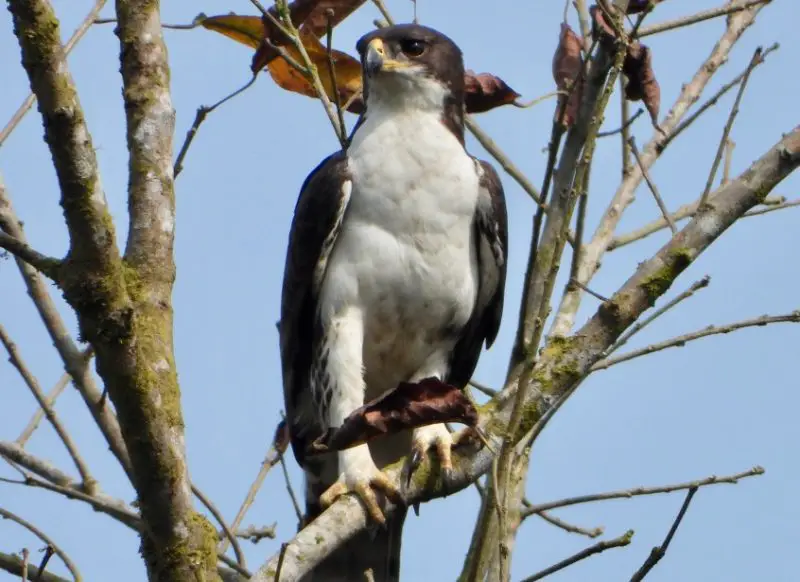
Cassin’s Hawk-Eagle (Aquila africana) is a medium-sized raptor found in the forests of West and Central Africa. Known for its distinctive feathered legs and strong build, this species thrives in the dense canopies of primary and secondary rainforests, especially in regions spanning from Sierra Leone to Uganda. It is an agile hunter, adapting well to its forested environment, where it ambushes prey such as small birds and tree-dwelling mammals.
This eagle is rarely seen soaring high in open skies, preferring instead to navigate through the thick forest cover. Its call, a unique series of “kwe-kwe-yaaa” sounds, is often heard as it moves through the trees. Cassin’s Hawk-Eagle is vulnerable due to habitat destruction, and its population is affected by the fragmentation of the rainforests it inhabits. Conservation efforts are essential to protect this enigmatic bird and its forest environment.






